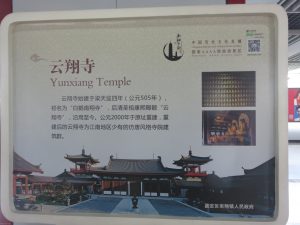Located in the Northwest of Shanghai in Jiading District is the town of Nanxiang (南翔镇). Metro line 11 has a stop here.
Jiading district covers 464 km2 is between the Liuhe River (north) and the Suzhou Creek (south). It borders Jiangsu province to the north and west, Baoshan and Puto districts to the east, Changning, Minhang and Qingpu districts to the south.
In Chaxi, a traditional farming community, it is said that around 500 AD, as farmers were removing a large rock from the ground, a pair of red-crowned cranes (xian he; 仙鹤; 丹顶鹤) flew overhead, which was taken as a auspicious event (the rarly seen birds represent nobility, luck, longevity, fidelity and immortality [in Taoism]). A Buddist monk named Deqi established a temple at the location in 505 AD and called it Baihe Nanxiang Temple. A small town formed around the temple, which is Nanxiang proper. The original temple was destroyed piece by piece by fire and weather. The current site is called Yun Xiang Si (云翔禅寺) and was built in 2004.
Guyi (from ‘lu zhu yi yi’ or vast land of green bamboo’) Garden (218 Huyi Highway) was a private garden from the Ming Dynasty (大明;Empire of the Great Ming; 1368–1644). It is a recreation of private gardens of Suzhou with a focus on bamboo (a symbol of vitality, longevity and morality). It covers 100,000m2 and also included pavilions, carved pillars and a varity of flowers such as peonies and lotus. In modern times it used by locals as a place for exercise, dance, singing and playing instruments. Another Ming-era Suzhou style garden is called Tanyuan Garden (5 Huntang Alley), which was owned by Li Liufang, a local poet, calligrapher and painter.
Nanxiang style Xiaolongbao (bamboo steaming basket [xiaolong] bun [bāo]; Also called sioh-lon meu-doe, Soup Dumpling, Soup Bun [tang bao], Soup Filled Bun [Guantang Bao], xiaolong-style mantous [mantou {Wu} or barbarian’s head is meat stuffed into a bun from around 220-280 AD {Wu, Eastern Wu, Sun Wu, or Three Kingdoms period}; mántóu, 蠻頭, 饅頭]; in Nanxiang style, it contains aspic [or pork jelly] which becomes a liquid when steamed and may be crowned with 14 decorative pinch marks in a circle).

I see your writing takes a lot of time.
very clear and indetail. thanks. I know Nan Xiang mantou is very famous, also long long history